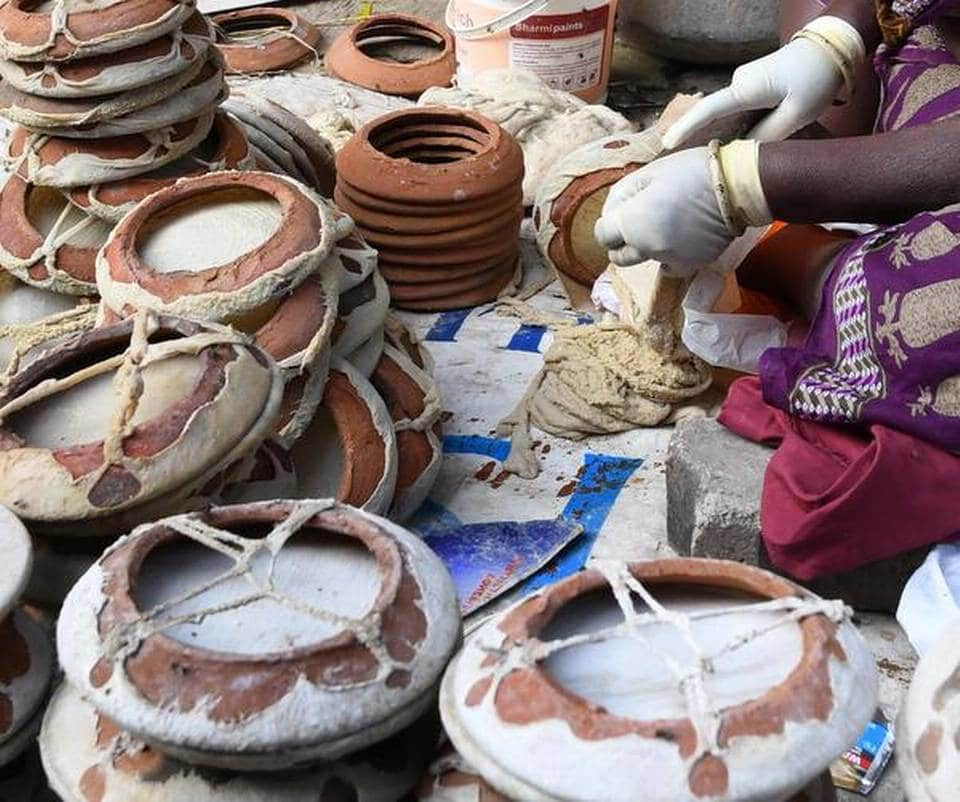Played on the night of Bhogi, the instrument is handcrafted by a small community in North Chennai
Its lifespan is just a few hours. Yet, molam, a hand-drum, lives and leaves gloriously. Says PR Munnaiyyan, who’s been making the instrument ever since he can remember: “Traditionally, we play it at midnight on Bhogi. Once we get rid of old things and clothes, we break the molam too. We believe that by doing so, we get rid of all negativity and start afresh from Pongal day.” The instrument, with its raw sound that’s fiery and melancholic at the same time, holds within it decades of history.
Behind the molam is a 2,500-strong community in Gurusamy Nagar, Pulianthope. “We are all shoe makers,” says Munnaiyyan. However, the 50-year-old adds that ever since bigger companies swallowed crafts such as theirs, most of his peers have taken to other jobs. He himself turned auto driver some five years ago. But his family continues to make the molam, a tradition since the days of his father C R Raj Kannu.
“At present, only a few families make the instrument in this locality,” explains Munnaiyyan. “Our work is similar to the firecracker-makers. We work through the year to keep the stock ready and sell them in January.” Every year, the artisans place orders for the base of the molam with potters in places such as Kanchipuram, Velur, and Arakkonam. They call this ‘kala odu’. It looks like the mouth of a clay pot, without the body.
Slaughter houses supply them with cow skin. “We clean it, and soak it in kilinjal sunnambu (limestone made from seashells) for two days,” says Munnaiyyan. The skin will now resemble thick cotton cloth. “We then dry it in the sun. It takes around three days on average, but if it’s sunny, a day will suffice,” he adds. Using a knife called ‘thagadu’, the artisans carve out the cured skin according to their requirement.
One of a kind
The final step, that of tying the skin to the clay base, is crucial. Munnaiyyan says that only two women from the community are trained to do it. “Only one of them is alive,” he says. She’s G Rajammal, whose age Munnaiyyan places around 70. She gives the finishing touch and can tie 150 molams a day. “This requires practice, since the skin has to be handled carefully. Otherwise, it can cut your hands,” observes Munnaiyyan.
Most of the work — apart from sourcing the raw material and selling it — is done by women. Munnaiyyan’s wife Gomathi, for instance, uses an annakoodai(wide-mouthed trough) to soak the skin in limestone. “She dries it on the terrace or any place where there’s good sunlight in our locality,” he says.
Gomathi is learning the art of tying the molam from Rajammal. She works from 9 am to 7 pm these days, since orders are high on days leading to Bhogi. “I don’t cook on such days; we mostly live on outside food,” she says. Also, Gomathi doesn’t touch food once she’s put on her gloves to work. “I start work after breakfast; my next meal is after 7 pm.”
Munnaiyyan sells the instrument at wholesale prices. “From ₹8 to ₹11 a piece, depending on size,” he says. With factory-made plastic molams from outside Tamil Nadu flooding the market, these artisans feared if this craft too will wither like shoe-making did. “But the plastic ban has given us hope,” says Munnaiyyan. “From next year, our business will increase manifold and people who previously gave up the craft, will take it up again.” People like him look down on the plastic copycats. “What’s the point when you can’t break them, as tradition demands?” he asks.
Is he sad that something he and his family work hard on through the year, is so short-lived? “No,” he says, “I see it as something that gives people positivity.” As an afterthought, he adds, “But yes, it lasts just a day.”
source: http://www.thehindu.com / The Hindu / Home> News> Cities> Chennai / by Akila Kannadasan / January 14th, 2019
